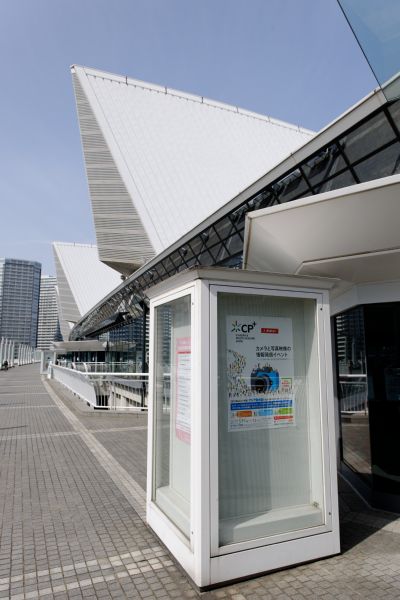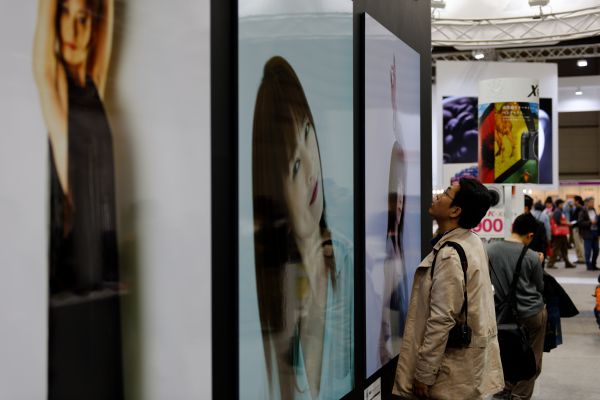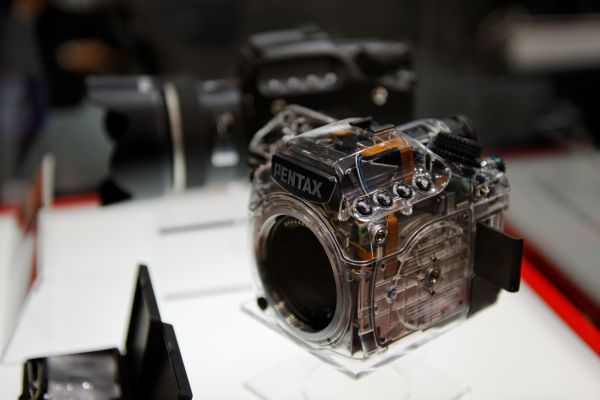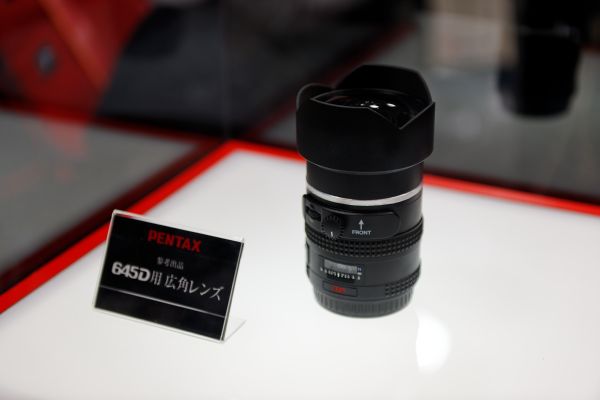By Bernard LANGUILLIER
Following many years of lukewarm presence in Big Site Odaiba under the brand Photo Imaging Expo (PIE), the Japanese photo industry decided to shift gear and move the venue of their annual gear show to the promising Yokohama area. At the same time a new branding going by the cute name of CP+ was also announced.

Fig. 1: Yokohama Pacifico
I had the chance to visit the show with a special focus on the newly announced Pentax 645D. The 645D was shown as a mock up last year in Odaiba along with a renewed ambitious attitude focusing on a 2010 release at an aggressive price.
The loop is now closed as of March 10th 2010 with the official announcement of the camera.
The outcome is very exciting and pretty much faithful to the rumors that had been showing up on the web these past few weeks.
– 40 mp latest Kodak sensor 44x33mm large without AA filter
– Fully weatherized body
– 850.000 Yen (US $9,400) price with a planned availability of mid-May 2010 in Japan.
The 645D was the star of the Pentax booth with a counter called “Touch and Try” making it possible to play with six production bodies (the firmware is still undergoing final tweaks). Very large prints made from 645D files were also on display (they must have been 2 meters wide) and I have to say that coming from a stitching background, I was impressed by the quality achieved with a single image. A few B0 portraits were also on display and were just as impressive with no visible moiré, the processing the image went through was not detailed though.


Fig. 2 & 3
Large prints from the 645D examined carefully at the Pentax Booth
I had the chance to speak with Pentax Product Planning executiveYasuyuki Maekawawho shared some interesting information about the philosophy of the 645D and background behind some key design decisions.
Could you please summarize the main features of the 645D?
Well the 645D is the first digital Medium Format camera released by Hoya Pentax. It is based on a Kodak 40 megapixel 44x33mm AA filterless sensor of the latest generation. The base ISO of the body is ISO200 with an upper limit at ISO1000 and excellent DR is available across the range.
The 645D has a fully weatherized body built on top of a robust magnesium body on top of a rigid aluminium frame. A first for MF digital, the sensor is fitted with a dust removal system. Other interesting features include a new 11 point AF system, 2 axis electronic level and hardened glass panels on both rear and large upper LCD screens. From a usability standpoint it is fair to say that the 645D is closer to a DSLR than to a traditional MF body.
Along with the body, we also announced a first 55mm lens in a new D FA series usable on film bodies but optimized for digital usage. They lenses are fully weatherized as well.
The camera and new lens will become available in Japan in May 2010.
Fig. 4: 645D weather re-enforcements
The MF market worldwide has been shrinking a lot these past few years, designing such a new ambitious body from the ground up could be seen as a risky investment. Why did Pentax decide to proceed with the 645D?
We believe that many photographers who used to own our film bodies are looking for a reasonably affordable digital solution that would enable them to keep using their lenses while delivering all the values of digital bodies.
The price point is key here. We have seen high end DSLR selling for 7000-8000 US$ capture a significant part of the traditional MF market and this tells us that people would be willing to spend that much for a suitable solution.
I cannot tell you exactly how many people will buy a 645D, but to give you just one example, we already recorded 15 firm orders in one single retail store in Tokyo the very day of the announcement, that is before any of these photographers had the opportunity to lay their hands on a body. We find this very encouraging. We are confident in our ability to sell several thousand bodies in Japan this year.
Besides, we see the 645D as just a first step. We firmly intend to follow up with more MF bodies in the coming years to stay close to the forefront of image quality.
Speaking about the price, competitive offerings typically sell in Japan for 3 times as much as the announced price of the 645D. How did you manage to achieve such a low price, and what does that mean in terms of positioning relative to the rest of the market?
Several factors helped with cost. The first is the target price itself. By selecting a price point that we believe is accessible to many potential buyers we could build a business plan that allowed us to get lower prices for sourced components like the sensor thanks to the higher quantities we order.
Another aspect is that we managed to commonalize some components with DSLRs already in production and could also re-use many of the IP and technologies we developed for them. The weather sealing I mentioned already is a very good example coming from the Pentax K-7. The new 11 points AF system also comes from existing DSLR technologies. We believe that we are the only ones on the market with a combined experience of MF and digital technologies in smaller bodies.
From a development standpoint also, the 645D was developed by a team made up of engineers having worked on the K-7 together with engineers belonging to our previous film 645 team.
Some aspects were of course developed specifically for the 645D though, like the magnesium outer shell or the aluminum frame supporting the sensor and other key components for accurate and reliable positioning.
Frankly speaking, we are happy about the outcome. We see the positioning of the 645D as fitting between the best full frame DSLRs and other MF digital offerings. We are really close to the DSLRs in terms of pricing, usability and features but still managed to reach a level of image quality similar to that of the high end MF backs.
Was the 645D designed with specific applications in mind?
Many of our existing 645 film users use them to shoot landscape in various harsh outdoor conditions. We see landscape as the prime application for the 645D and many design decisions were taken accordingly. This is not to say that the 645D cannot be used for other photographic endeavors, it does in fact excel at many other things also but we believe that the unique weather sealing, outstanding battery life in cold weather (we measured 650 frames at -10C on one battery charge) will be most attractive for landscape.
Regarding weather sealing, the 645D has been developed with very high standards in mind. It cannot be immerged, but will resist whatever amount of pouring rain for whatever amount of time.
As mentioned in the introduction we decided not to fit the sensor of the 645D with an AA filter. This is a first for us and we were frankly concerned about possible issues like moiré. As the result of many trials and the analysis of many images, we realized that moiré was in fact not as big an issue as we had anticipated. This is especially true for landscape images where repeated patterns likely to generate moiré are few.
We also know that moiré can be removed with software reasonably easily were it to show up in some images like fashion shots for instance. Our feeling is that customers who would want to use the 645D for such applications have the level of digital skills required to deal with such issues anyway.
On the other hand, we have done a lot to make the 645D as easy to use as possible for landscape photographers who would be new to digital. It is possible for instance to shoot raw and convert the raw file to a jpg within the camera without having to use a PC or a Mac. We have also defined a custom image mode simulating the rendition of some of the slide films often used by landscape photographers in Japan. When using these capabilities, it is possible for the photographer to just hand over a memory card to photo printing company just like they used to hand out their cans of slides. We believe that this will help some of our traditional customers enter the digital world.
You mentioned that the 645D is close to high end backs in terms of image quality. DR is an important and much debated factor these days. How do you feel the 645D fares DR-wise?
Well, the first thing to say is that the 645D delivers very clean images and we believe the photographers using the body will be happy about the DR they will experience.
DR is mostly the result of the sensor being used together with the processing being performed to the image. We are extremely proud about the quality of the processing engine we have developed for the 645D building on our long DSLR experience.
The Kodak sensor itself is already very clean compared to previous MF sensors generations and Kodak might in fact be a bit conservative when they quote 11.5 stops as being the sensor DR. On the other hand we realize that DSLR sensors have also progressed a lot these past few years and the gap in DR when considering the sensor alone is not that large.
The real difference results from the processing pipe and we are happy about the level we have reached here.
Most MF digital backs can be used independently from the body while the 645D is an integrated offering, why have you taken this design decision?
Several factors impacted our decision. The first one is the target application for the 645D. We wanted to deliver a very rugged solution able to take whatever is thrown at it and it appeared challenging to ensure such a level of reliability with a separate back.
Another concern was communication issues between back and body that have been affecting some solutions. We didn’t want our customers to suffer from such issues.
Finally, considering the very high image quality that can be achieved with the MF sensors, we believe that it is difficult to manage well tolerances between 2 separate devices. Having an integrated solution enables us to position extremely accurately the sensor relative to the mount for best possible results image quality wise.
Will the 645D become available outside Japan?
We intend to sell the 645D outside Japan at a certain point in time but I cannot give you a firm date today. We believe that such a high end body has to be sold on top of a suitable support infrastructure. Japan as our historical base was the market with the best readiness for such a launch, which is why we decided to control the availability in this first step.
Two potentially important features that appear not to be available as of now are Live view and tethered shooting, what is your view on these.
Well, we recognize the value of live view as a tool. We would have loved to make it available in the 645D, but the Kodak CCD sensor that we have selected, just like all the other MF sensors available today for that matter, do not currently enable Live view. We hope that possible future CMOS based MF sensors would be able to lift this limitation.
As far as the ability to control the camera remotely, we are currently investigating this possibility but it is too early to commit on an availability date or to provide visibility on aspects like performance.
We believe that some of the applications typically handled with remote shooting could perhaps be covered using the HDMI output available on the 645D since it makes it possible to export the display of the camera to a large LCD screen, but we will nonetheless keep investigating connected shooting thoroughly to meet customer needs.
You mentioned the introduction of a new 55mm lens, how about the usability on existing lenses on the 645D. Besides do you have plans for more lenses?
All the legacy lenses of the Pentax AF system can be used as-is on the 645D. Most of them are already at the right level quality wise but we are frankly speaking not totally happy about the wide end.
Therefore we plan to release soon a new wide high-end lens that will complement our existing wide lineup and be able to fully realize the image quality potential of the sensor for wide applications. It is also going to restore some of the wide capability that we have lost because of the smaller size of the sensor used in the 645D compared to 645 film.
It is too early to speak about price and dates, but we are very excited by this new offering.
Fig. 5: Prototype of new wide lens for 645D
The 645D features a double SD slot, this came a bit as a surprise for shooters used to CF cards in other high end camera. What are the reasons for this choice?
Here also, we decided for SD by considering several factors. First, we believe that SD has more potential as a long term storage standard than CF that is sort of reaching the end of its life cycle as a technology.
Besides, keeping the body of the 645D as compact and light as possible was high on our list of priorities and the SD cards are obviously smaller.
Finally, we heard complains from several photographers about bended pin issues with CF cards that, considering the main target usage of the camera, we wanted to avoid also.
My final question will be on raw format and conversion. Besides the native Pentax PEF raw format the 645D can also output raw data in Adobe DNG format. What are the differences and what solution are you going to provide for raw conversion?
One key difference used to be the inability of DNG to handle compression, but this issue has now been solved and we fully support and recommend the usage of DNG.
Our Pentax software Digital Camera Utility 4.0 is of course able to convert the raw files generated by the 645D, but we intend to make sure that more generic raw converters from other vendors also support the 645D raw files.
March, 2010
Bernard Languillier is a landscape photographer based in Tokyo, Japan.
Some of his work can be seen online atwww.light-of-earths.com


